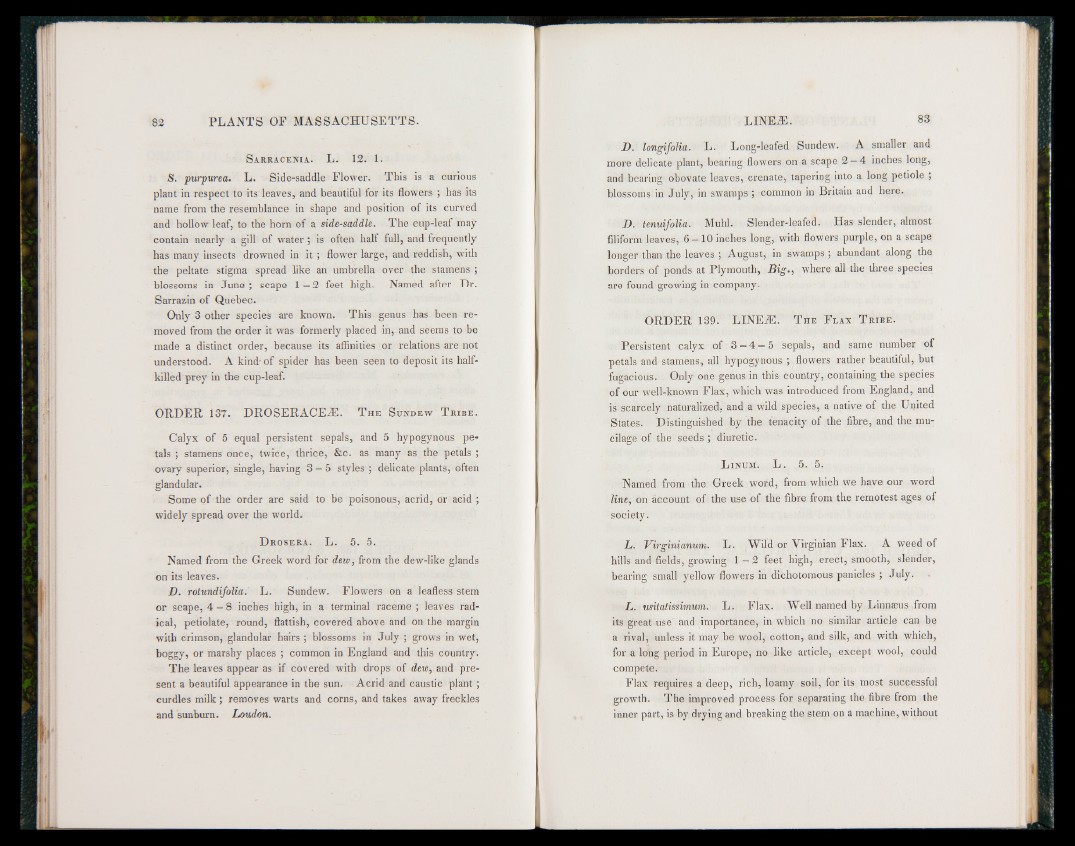
Sarracenia. L. 12. 1.
S. purpurea. L. Side-saddle Flower. This is a curious
plant in respect to its leaves, and beautiful for its flowers ; has its
name from the resemblance in shape and position of its curved
and hollow leaf, to the horn of a side-saddle. The cup-leaf may-
contain nearly a gill of water; is often half full, and frequently
has many insects drowned in it ; flower large, and reddish, with
the peltate stigma spread like an umbrella over the stamens ;
blossoms in Ju n e ; scape 1—2 feet high. Named after Dr.
Sarrazin of Quebec.
Only 3 other species are known. This genus has been removed
from the order it was formerly placed in, and seems to be
made a distinct order, because its affinities or relations are not
understood. A kind- of spider has been seen to deposit its half-
killed prey in the cup-leaf.
ORDER 137. DROSERACEiE. T he Sundew T ribe.
Calyx of 5 equal persistent sepals, and 5 hypogynous petals
; stamens once, twice, thrice, &c. as many as the petals ;
ovary superior, single, having 3 — 5 styles ; delicate plants, often
glandular.
Some of the order are said to be poisonous, acrid, or acid ;
widely spread over the world.
D rosera. L. 5. 5.
Named from the Greek word for dew, from the dew-like glands
on its leaves.
D. rotundifolia. L. Sundew. Flowers on a leafless stem
or scape, 4 — 8 inches high, in a terminal raceme ; leaves radical,
petiolate, round, flatfish, covered above and on the margin
with crimson, glandular hairs ; blossoms in July ; grows in wet,
boggy, or marshy places ; common in England and this country.
The leaves appear as if covered with drops of dew, and present
a beautiful appearance in the sun. Acrid and caustic plant ;
curdles milk ; removes warts and corns, and takes away freckles
and sunburn. Loudon.
D. longifolia. L. Long-leafed Sundew. A smaller and
more delicate plant, bearing flowers on a scape 2 - 4 inches long,
and bearing obovate leaves, crenate, taperipg into a long petiole ;
blossoms in July, in swamps ; -common in Britain and here.
D. tenuifolia. Muhl. Slender-leafed. Has slender, almost
filiform leaves, 6 -1 0 inches long, with flowers purple, on a scape
longer than the leaves ; August, in swamps; abundant along the
borders of ponds at Plymouth, Big., where all the three species
are found growing in company.
ORDER 139. LINEiE. T he F lax T ribe.
Persistent calyx of 3 - 4 - 5 sepals, and same number of
petals and stamens, all hypogynous ; flowers rather beautiful, but
fugacious. Only one genus in this country, containing the species
of our well-known Flax, which was introduced from England, and
is scarcely naturalized, and a wild species, a native of the United
States. Distinguished by the tenacity of the fibre, and the mucilage
of the seeds ; diuretic.
Linum. L. 5. 5.
Named from the Greek word, from which we have our word
line, on account of the use of the fibre from the remotest ages of
society.
L. Virginianum. L. Wild or Virginian Flax. A weed of
hills and fields, growing 1—2 feet high, erect, smooth, slender,
bearing small yellow flowers in dichotomous panicles ; July.
L. usitatissimum. L. Flax. Well named by Linnaeus from
its great use and importance, in which no similar article can be
a rival, unless it may be wool, cotton, and silk, and with which,
for a long period in Europe, no like article, except wool, could
compete.
Flax requires a deep, rich, loamy soil, for its most successful
growth. The improved process for separating the fibre from the
inner part, is by drying and breaking the stem on a machine, without